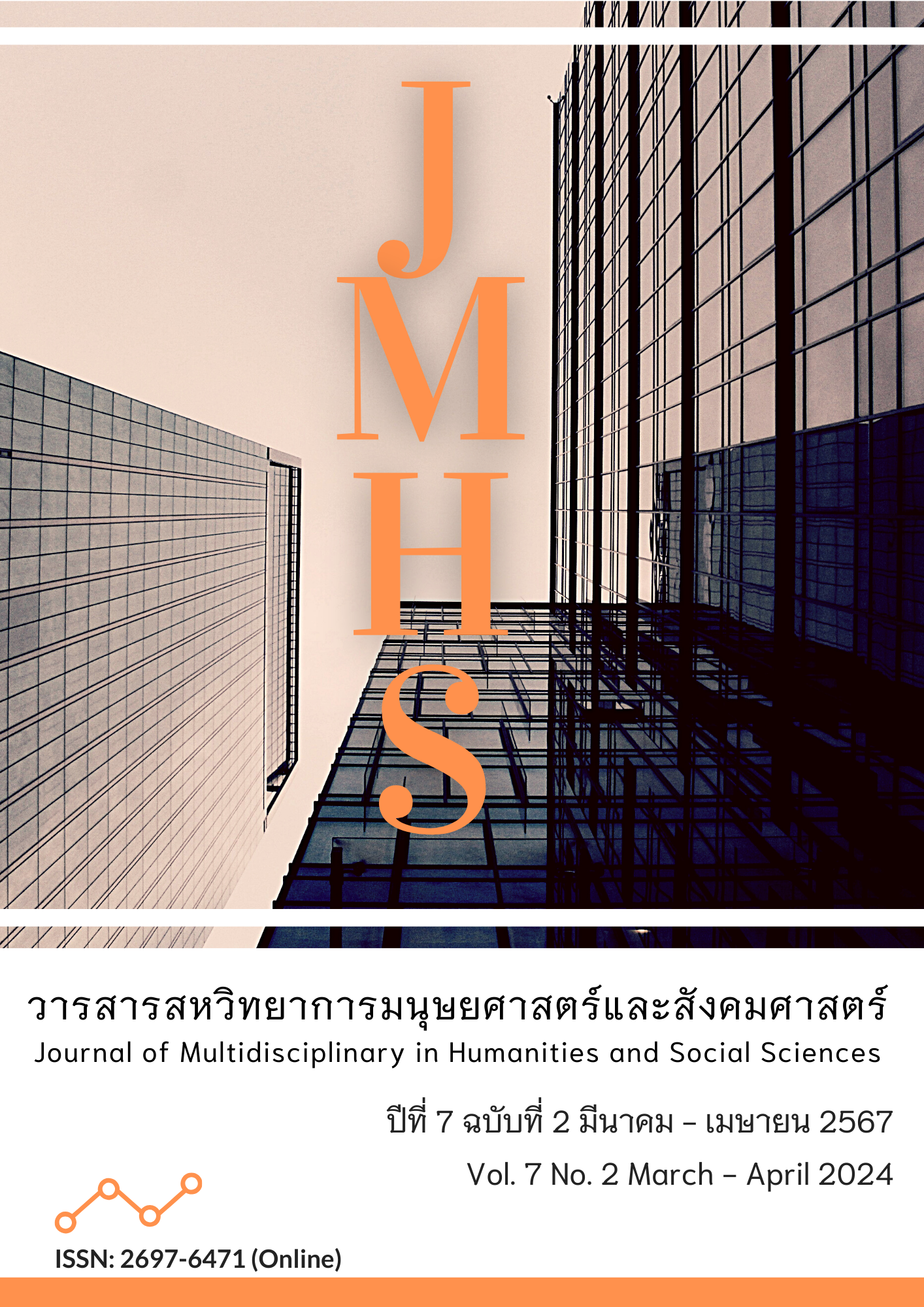The Influence of The Development of Monozukuri Production Personnel, Kaizen Event, and Japanese Communication on The Operational Performance of Staff
Main Article Content
Abstract
This article aimed to: 1. develop and validate a causal structural relationship model of Monozukuri production personnel development, Kaizen events, and Japanese communication on operational performance; and 2. analyze and compare the direct and indirect effects of factors influencing operational performance. This research was conducted using questionnaires as an instrument to collect data from 238 staff with stratified random and convenience sampling. This process was completed using structural equation modeling (SEM) and part analysis. The results suggested that the theoretical model and empirical data showed a good fit of χ2 = 238.62, df = 89, χ2/df = 2.692, p = 0.00, CFI = 0.97, GFI = 0.92, RMR = 0.02, RMSEA = 0.05, It was found that Monozukuri personnel development had a direct effect on operational performance of 0.25, an indirect effect on operational performance through Kaizen events and Japanese communication as an intervening factor of 0.69, and a total effect of 0.94 on staff.
The practical contribution is that staff who are responsible for increasing operational performance must continue to enhance Monozukuri personnel, Kaizen events, and Japanese communication components in quality for increased operational performance.
Article Details

This work is licensed under a Creative Commons Attribution-NonCommercial-NoDerivatives 4.0 International License.
Views and opinions appearing in the Journal it is the responsibility of the author of the article, and does not constitute the view and responsibility of the editorial team.
References
บุญญาดา นาสมบูรณ์. (2563). อิทธิพลตัวแปรคั่นกลางของกิจกรรมการปรับปรุงอย่างต่อเนื่องระหว่างการบริหารแบบญี่ปุ่นกับการลดต้นทุนในเขตนิคมภาคเหนือของประเทศไทย. วารสารเศรษฐศาสตร์และกลยุทธ์การจัดการ, 7(2), 140-156. สืบค้นจาก https://kuojs.lib.ku.ac.th/index.php/jems/article/view/3148
วิฑูรย์ สิมะโชคดี. (2555). Productivity for SMEs การเพิ่มผลผลิตและลดต้นทุนสำหรับผู้ประกอบการ SMEs. (พิมพ์ครั้งที่ 3). กรุงเทพฯ: สมาคมส่งเสริมเทคโนโลยี (ไทย-ญี่ปุ่น).
Aoki, K. & Staeblein, T. (2018). Monozukuri Capability and Dynamic Product Variety: An Analysis of Design-Manufacturing Interface at Japanese and German Automaker. International Journal of Operation & Production Management, 28(6), 518-539. https://doi.org/10.1016/j.technovation.2017.10.008
Berhe, H. H., Gebremichael, H. S., & Beyene, K. T. (2023). Development, Validity and Verification of Innovative Integrated Kaizen Philosophy (CI) Framework and Its Implementation Procedure for Enhancing Manufacturing Industry Sustainable Competitiveness. International Journal of Quality and Reliability Management, 40(10), 2463-2518. https://doi.org/10.1108/ijqrm- 08-2022-0258
Byrne, B. (2009). Structural Equation Modeling with AMOS: Basic Concepts, Applications, and Programming. (2nd ed.). New York: Taylor and Francis.
Chau, V. S., & Nacharoenkul, T. (2023). Japanese Business Communication Practice in Thailand: Tales from an Electronic Components Manufacturer. Management Decision. 61(8), 2467-2490. https://doi.org/10.1108/MD-08-2022-1092
Habidin, N. F., Hashim, S., Fuzi, N. M., & Salleh, M. I. (2018). Total Productive Maintenance, Kaizen Event, and Performance. International Journal of Quality & Reliability Management, 35(9), 1853-1867. https://doi.org/10.1108/IJQRM-11-2017-0234
Hata T. (2016). Personnel Development Manoukian Style. Bangkok: TPA Publishing.
Hair, J. F., Black, W. C., Babin, B. J., & Anderson, R.E. (2014). Multivariate Data Analysis. (7th ed.). New York: Pearson.
Imai, M. (1986). KAIZEN, The Key to Japan’s Competitive Success. New York: McGraw-Hill.
Kannan, K. S., & Garad, A. (2021). Competencies of Quality Professionals in The Era of Industry 4.0: A Case Study of Electronic Manufacturer in Malaysia. International Journal of Quality & Reliability Management, 38(3), 839-871. https://doi.org/10.1108/IJQRM-04-2019-0124
Kline, R. B. (2011). Principles and Practice of Structural Equation Modeling. (3rd ed.). New York: The Guilford Press.
Kumar, S., Dhingra, A., & Singh, B. (2018). Lean-Kaizen Implementation. A Roadmap for Identifying Continuous Improvement Opportunities in Indian Small and Medium Sized Enterprise. Journal of Engineering Design and Technology, 16(1). 143-160. https://doi.org/10.1108/JEDT-08-2017-0083
Musheke, M., & Phiri, J. (2021). The Effects of Effective Communication on Organizational Performance Based on System Theory. Open Journal of Business and Management, 9(2), 659-671. https://doi.org/10.4236/ojbm.2021.92034
Neely, A., Mills, J., Platts, K., Richards, H., Gregory, M., Bourne, M., & Kennerley, M. (2007). Performance Measurement System Design: Developing and Testing a Process-Based Approach. International Journal of Operations & Production Management, 20(10), 1119-1145. https://doi.org/10.1108/01443570010343708
Noguchi, S. (2007). Horenso no Kihon & Jissenryoku ga Ichi Kara Minitsuku Hon: Dekiru Hito ni Naru Tameno Hissu Sukiru. Tokyo: Subarusha.
Shrafat, D. F., & Ismail, M. (2019). Structural Equation Modeling of Lean Manufacturing Practices in a Developing Country Context. Journal of Manufacturing Technology Management, 30(1), 122-145. https://doi.org/10.1108/JMTM-08-2017-0159
Suárez-Barraza, M. F., Ramis-Pujol, J., & Kerbache, L. (2011). Thoughts on Kaizen and Its Evolution-Three Different Perspectives and Guiding Principles. International Journal of Lean Six Sigma, 2(4), 288-308. https://doi.org/10.1108/20401461111189407
Voss, C., Tsikriktsis, N., & Frolich, M. (2002). Case Research in Operations Management. International Journal of Operations & Production Management, 22(2), 195-219. https://doi.org /10.1108/01443570210414329


